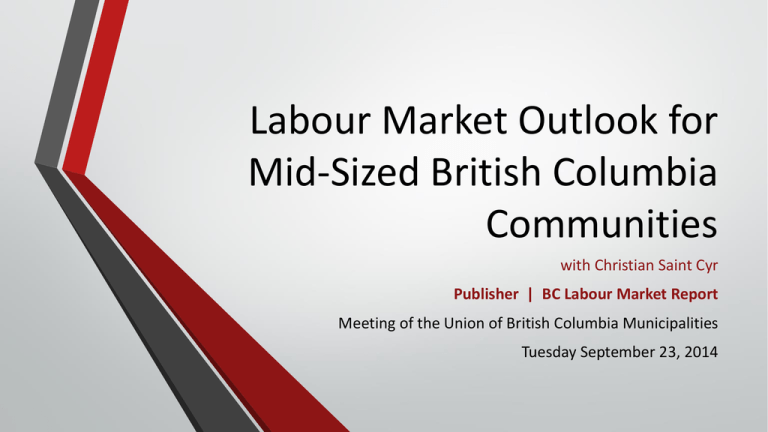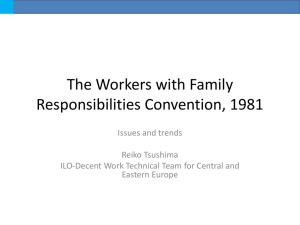Labour Market Outlook for Mid-Sized British Columbia Communities
advertisement

Labour Market Outlook for Mid-Sized British Columbia Communities with Christian Saint Cyr Publisher | BC Labour Market Report Meeting of the Union of British Columbia Municipalities Tuesday September 23, 2014 Labour Market Outlook for Mid-Sized British Columbia Communities British Columbia is about to embark on a period of nearly unprecedented growth. CONSTRUCTION AND OPERATIONS JOBS Labour Market Outlook for Mid-Sized British Columbia Communities Excluding LNG, we’re still factoring in $60 billion in major projects . Labour Market Outlook for Mid-Sized British Columbia Communities Demographic Challenges 800,000 BC’s population: 600,000 400,000 Slow growth of new labour force entrants expected 200,000 0 1990 1995 2000 2005 2010 2015 2020 2025 2030 2035 Labour Market Outlook for Mid-Sized British Columbia Communities Demographic Challenges 800,000 BC’s population: 600,000 400,000 Retirement-aged population to experience significant growth 200,000 Expected to peak in 2021 0 1990 1995 2000 2005 2010 2015 2020 2025 2030 2035 Labour Market Outlook for Mid-Sized British Columbia Communities Demographic Challenges BC’s aging population 800,000 Population aged 20-29 Population aged 55-64 600,000 In 2016, number of retirement-aged British Columbians (55-64 years) will surpass those aged 20-29 (potential new labour force entrants) 400,000 200,000 0 1990 1995 2000 2005 2010 2015 2020 2025 2030 2035 Labour Market Outlook for Mid-Sized British Columbia Communities Demographic Challenges How many job openings are expected? • 1,027,400 job openings are expected for B.C. over the next ten-year period • Close to two-thirds of job openings (676,400) will be due to replacement demand as a result of retiring workers and deaths • The other one-third of job openings (351,000) will be due to the new jobs that result from economic growth • Demand for workers in B.C. is expected to grow by an annual average rate of 1.4% over the ten-year period Future Job Growth Retirements Econ Growth Labour Market Outlook for Mid-Sized British Columbia Communities Which sectors will create the greatest numbers of new jobs by 2020? Labour Market Outlook for Mid-Sized British Columbia Communities With the pressure of growing business with fewer workers, what actions will many employers utilize? • Contracting out low-skill or specialized activities internationally or to independent contractors • Introduce new types of technology • Seek out organizational efficiencies • Increase wages and other employment benefits • Develop recruiting strategies for under-represented members of the labour market Labour Market Outlook for Mid-Sized British Columbia Communities Groups which can be better utilized in the labour market include: •Aboriginals •Those with Disabilities •Youth •Older Workers •Immigrants •Individuals with Multiple Barriers to Employment Labour Market Outlook for Mid-Sized British Columbia Communities The challenge of our labour market is not a labour shortage but a skills shortage Over 77% of All Jobs Will Require Post-Secondary Education Labour Market Outlook for Mid-Sized British Columbia Communities Occupations experiencing or expected to experience shortages: • • • • • • • • • • Managers in Health, Education, Social and Community Services, Construction and Transportation Auditors, Accountants and Investment Professionals Human Resources and Business Service Professionals Professional Occupations in Natural and Applied Sciences Physical Science Professionals / Life Science Professionals Civil, Mechanical, Electrical and Chemical Engineers Pharmacists, Dietitians, Nutritionists, Nurse Supervisors and Registered Nurses Medical Technologists and Technicians Psychologists, Social Workers, Counsellors, Clergy and Probation Officers Underground Miners, Oil and Gas Drillers and Related Workers Labour Market Outlook for Mid-Sized British Columbia Communities Occupations experiencing an over-supply of labour: • • • • • • • • • • Clerical Supervisors and clerical Occupations Office Equipment Operators Finance and Insurance Clerks Mail and Message Distribution Occupations Sales and Service Supervisors / Cashiers Secondary & Elementary Teachers and Counsellors Sales and Service Supervisors, Cashiers Butchers & Bakers Upholsterers, Tailors, Shoe Repairers, Jewellers and Related Occupations Fishing Vessel Masters and Skippers and Fishermen/Fisherwomen Labour Market Outlook for Mid-Sized British Columbia Communities BC Skills for Growth Labour Market Strategy Labour Market Outlook for Mid-Sized British Columbia Communities Employment Programs such as the Employment Program of B.C. and ASETSfunded Employment Programming for Aboriginals • • • • • • • • Aboriginal Business Entrepreneurship Skills Training (BEST) Aboriginal Training and Employment Program (ATEP) BladeRunners Employment Skills Access Initiative Immigrants in Trades Training Job Options BC Job Options BC - Urban Older Workers Labour Market Sector Solutions • • • • • • • • • Skilled Trades Employment Program (STEP) Skilled Trades Employment Program (STEP) – Job Match Services Skills Connect for Immigrants Targeted Initiative for Older Workers (TIOW) Targeted Skills Shortage Pilot Program Trades Training for Aboriginal People Women in Trades Training Women’s Mentorship Program Youth Skills BC - Workplace Program Labour Market Outlook for Mid-Sized British Columbia Communities Employment Program of B.C. Launched April 2, 2012 after over 2 years of consultations 85 WorkBC Employment Services Centres (ESCs) throughout BC 100+ satellite offices with outreach and itinerant services ESCs provide a range of services to any unemployed British Columbian Assist clients to become employment ready and find & sustain a job Labour Market Outlook for Mid-Sized British Columbia Communities Employment Program of B.C. The EPBC has served 160,449 people, with over 80% receiving case management 38,776 employment outcomes achieved Program has achieved an overall employment rate of about 42% Employment outcome rate is nearly 80% for clients who have completed case management EI clients account for 36% and BCEA clients account for nearly a third of all clients 91,076 self identified as being from one or more specialized populations Labour Market Outlook for Mid-Sized British Columbia Communities Employment Program of B.C. | Specialized Populations 20,000 18,000 16,000 14,000 12,000 10,000 8,000 6,000 4,000 2,000 0 Persons with a disability Youth Multi-barriered Rural and remote populations Aboriginal people Immigrants Survivors of Francophone violence and/or abuse Labour Market Outlook for Mid-Sized British Columbia Communities Planning for a Skills Shortage: Critical Next Steps • • • • • • Work with secondary school educators and public and private post-secondary instructions to ensure training programs reflect labour market demand. Encourage local employers to recruit individuals from under-represented populations such as Aboriginals, immigrants and those with disabilities. Adopt inclusive community policies to encourage immigrants to settle in the area. Support local employers with informing job seekers and youth about the employment opportunities in their own community. Encourage local businesses to adopt ‘employer of choice’ policies. Foster mentorship and co-op educational opportunities. Labour Market Outlook for Mid-Sized British Columbia Communities Planning for a Skills Shortage: Critical Next Steps • Develop economic development policies that take into consideration factors such as: • • • • • • Economic Shifts to a Knowledge and Service-based Economy Globalization Health and the Environment Technology and Education Self Employment Changing Age Demographics






